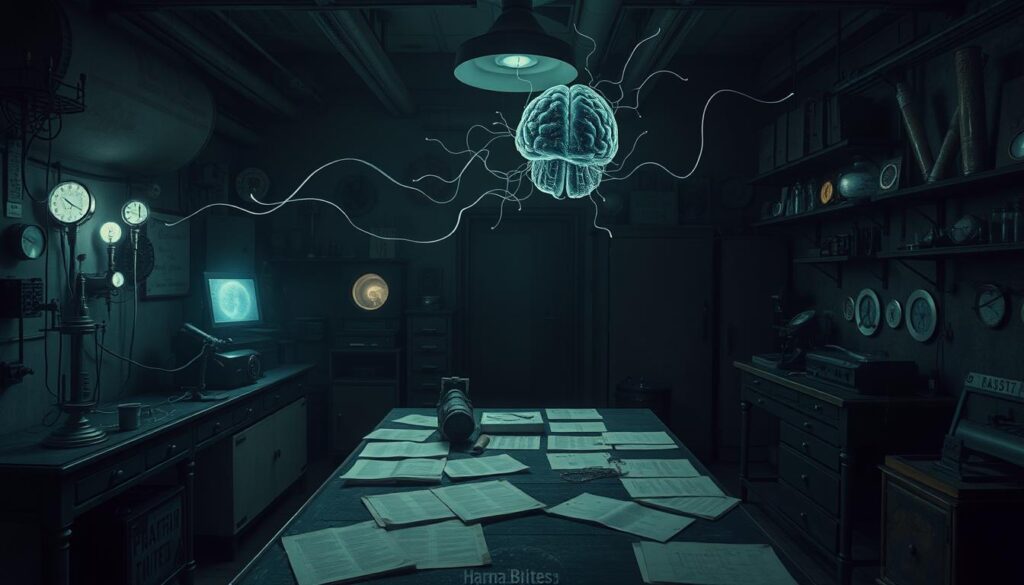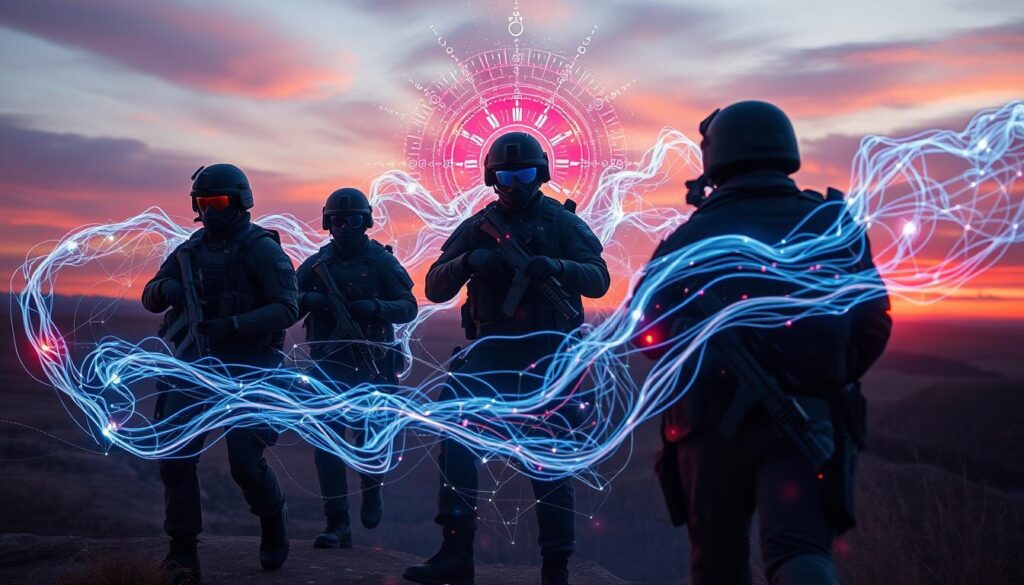The Cold War era saw the Soviet Union explore parapsychology research deeply. They looked into psychic abilities, extrasensory perception, and how the mind affects matter. Their efforts in paranormal studies were unmatched, even compared to Western nations.
Soviet scientists studied telepathy, psychokinesis, and remote viewing. Their work was often secret, with military uses in mind. This made the study of science and the supernatural a unique battlefield during that time.
While the U.S. had its own projects, like Project Stargate, the Soviet Union was more committed. They set up special institutions and invested heavily in psychic research. This mix of science and the unknown is a fascinating part of both psychology and military history.
Key Takeaways
- Soviet Union led in parapsychology research during the Cold War
- Studies focused on telepathy, psychokinesis, and remote viewing
- Research had potential military applications
- Dedicated institutions were established for paranormal studies
- Soviet efforts surpassed those of Western countries
- The research blended scientific methods with supernatural exploration
Historical Background of Soviet Psychic Research Programs
The Soviet Union started exploring psychic research after World War II. This was a mix of scientific curiosity and political goals. They wanted to use parapsychology to get ahead in the Cold War.
Origins in Post-World War II Era
In the late 1940s, Soviet scientists looked into psychic phenomena. As the Cold War grew, so did their research. By the 1970s, they were deeply studying ESP with lots of government support.
Marxist Philosophy and Paranormal Studies
The Soviet Union saw psychic phenomena through a Marxist lens. They thought these abilities could be studied and controlled like any other science. This fit with Marxist ideas of understanding and controlling nature.
Early Scientific Institutions
Several institutions led the way in psychic research in the USSR. They studied telepathy, psychokinesis, and remote viewing. Despite official claims, the government funded these programs well.
| Year | Event | Significance |
|---|---|---|
| 1989 | Anatoly Kashpirovsky’s TV séance | 57% of viewers “put everything aside” to watch |
| 1987 | World Championships | Soviet team won 10 golds using ’emotional-volitional training’ |
| 1970s | Rise in alternative beliefs | Increased interest in yoga, body-building, and parapsychology |
The Soviet Union’s interest in psychic phenomena grew. This was both in secret government studies and public fascination. This mix created a special place for parapsychology in the USSR.
Soviet Parapsychology Research: Methodologies and Approaches
Soviet researchers mixed science with unique methods in parapsychology. They studied remote viewing, telekinesis, and ESP. Their goal was to use psychic powers for real-world benefits.
Their mind reading studies were diverse. They used both classic science and new experiments. This mix helped them understand psychic phenomena better.
They also did a deep dive into literature. Top researchers looked at Russian and Western studies. This gave them a strong base for their work.
| Source | Number of References |
|---|---|
| Russian | 204 |
| Western | 225 |
| Pre-1940 Russian | 103 |
| Pre-1900 (Russian and Western) | 39 |
Soviet scientists also used tech to improve psychic communication. This was different from Western researchers, who mainly used psychological methods.
Their telekinesis trials were strict. They used controlled settings and had many observers. These tests aimed to prove and use psychokinetic powers.
The KGB’s Role in Paranormal Studies
The KGB was key in Soviet paranormal research. They managed top-secret projects and KGB investigations into psychic phenomena. Their work mixed science with espionage, keeping everything under wraps.
Secret Military Applications
The KGB’s psychotronic program aimed to use psychic powers for military goals. They looked into telepathy, remote viewing, and mind control. One experiment tried to send messages from a submarine to a naval base, with a 70% success rate.
Project Control and Oversight
KGB control was strict, with researchers in secret places like “Special Department No. 8” in Siberia. This lab had 60 workers and lots of resources. But, finding a physical basis for psychic energy was hard.
Intelligence Gathering Operations
The KGB used paranormal research for spying. They changed terms to sound more scientific, like “telepathy” to “bio-communication”. They even used electric shocks on kittens and TV for telepathic tests. Some Soviet research was so unique, it couldn’t be replicated, making Westerners skeptical.
“Formally, officially subsidized Soviet research in parapsychology has been ongoing for years.”
The KGB’s work in paranormal studies mixed science and espionage. This left a trail of mystery and questions about psychic warfare.
Key Soviet Scientists and Their Contributions
Soviet parapsychology research made big strides thanks to several key scientists. Their work, done in Russian parapsychology institutes, went beyond what was thought possible. They faced skepticism and political obstacles along the way.

Nina Kulagina was famous for her alleged psychokinetic powers. She could move small objects without touching them, sparking debate. Some doubted her abilities, but others saw her as a potential game-changer in understanding human consciousness.
Yuri Kholodov explored how electromagnetic fields affect the brain. His research showed how outside energy can change our thoughts and actions. This was key in developing theories about psychotronic weapons.
Mikhail Persinger, a Canadian, also made a big impact on Soviet parapsychology. He suggested that certain brain states could explain paranormal experiences. His work offered a scientific way to study these mysterious events.
| Scientist | Field of Study | Key Contribution |
|---|---|---|
| Nina Kulagina | Psychokinesis | Demonstrations of object movement without physical contact |
| Yuri Kholodov | Electromagnetic field effects | Research on brain-energy interactions |
| Mikhail Persinger | Neurology of paranormal experiences | Theories linking brain states to supernatural phenomena |
These scientists’ efforts greatly advanced parapsychology. Their work, done in Russian institutes, still shapes today’s studies on consciousness and human potential. It bridges the gap between science and the paranormal.
Psychotronic Weapons Development Programs
The Soviet Union explored psychotronic weapons to control human behavior with electromagnetic fields. This field combined science and the paranormal, expanding warfare’s limits.
Theory and Technical Aspects
Psychotronic weapons aimed to manipulate bioenergy. Scientists thought these devices could use psychoenergetic forces to change human physiology without touching. They believed electromagnetic pulses could change brain waves, controlling thoughts or actions.
Laboratory Testing Phases
Secret labs tested psychotronic theories with advanced tools. They measured energy fields and brain waves. Test subjects went through tough trials to see if these techniques worked.
Field Applications
Psychotronic weapons were tested in real-world scenarios. Military planners looked for ways to use them in battles. Though results are secret, some say they worked on enemy troops’ morale and decisions.
Psychotronic weapons changed how wars were fought. They mixed new science with old mind control ideas, opening a new military tech area. This research is still interesting to scientists and military experts today.
Remote Viewing Experiments and Results
Soviet remote viewing research was a big deal for decades. It was a secret program that tried to use psychic powers for spying. The Ministry of Defense and maybe the KGB funded it, looking into how far human senses can go.
ESP trials were key in these studies. Scientists used Zener cards to see if people could sense things without seeing them. These cards were simple but helped find people with special remote viewing skills.
The scope of Soviet remote viewing research was unique. Unlike open studies, these secret programs focused on what could be used in real life. This led to some interesting findings that made people want to keep exploring.
Even though many tests didn’t show much, some did. It was said that some remote viewers could describe places or objects they hadn’t seen. These successes kept the program going and well-funded for a long time.
“The reliability and information quality of paranormal phenomena under controlled conditions need quantification to assess their potential usefulness accurately.”
As the Soviet government got stricter with open research, secret programs got more attention. This showed how much interest there was in using psychic powers for spying. The search for an advantage in spying through psychic means went on until the Soviet Union fell.
Mind Control Research Initiatives
The Soviet Union explored mind control during the Cold War. They aimed to understand consciousness and change behavior. Their methods raised big ethical questions because of the human testing involved.
Behavioral Modification Studies
Soviet scientists worked hard on changing human behavior. They wanted to find ways to influence people’s choices. Their goal was to use these techniques for military or spy work.
Consciousness Manipulation Techniques
They looked into many ways to change how we think. This included using sensory deprivation, hypnosis, and drugs. They wanted to change how we see things and control our thoughts.
Ethics and Human Testing
The ethics of these studies were a big deal. People were often not told they were part of the experiments. This made people worry a lot about their rights and if they gave consent.
| Aspect | Soviet Research | US Research |
|---|---|---|
| Duration | 1950s-1990s | 1950s-1990s |
| Main Focus | Behavioral modification, consciousness manipulation | Remote viewing, psychic abilities |
| Funding | Government funded | $20 million over 20 years |
| Ethical Concerns | High, due to non-consensual human testing | Moderate, with some controversial programs like MK Ultra |
Today, we still see the effects of these mind control studies. They are now known to have been very wrong. Yet, they helped us understand more about how we behave and think.
Telepathy and ESP Studies in Military Context
Soviet military researchers explored telepathy and ESP during the Cold War. They wanted to create new ways to communicate and gather intelligence. Their goal was to use the mind’s power for military and espionage gains.
In the 1960s, the Soviet Union became very interested in telepathic communications. Research centers popped up all over Eastern Europe, with Bulgaria leading. In 1966, Bulgaria opened the world’s first lab for studying suggestion, a big step in ESP research.

As the Cold War got fiercer, ESP’s military use grew. By the 1970s, the Soviet Union made ESP research secret, focusing on its military value. Bulgarian schools even started teaching suggestology, showing how far-reaching these studies were.
| Year | Event | Impact |
|---|---|---|
| 1960s | Rise of telepathy research centers | Increased focus on parapsychology |
| 1966 | Bulgaria opens first suggestion lab | World’s first dedicated scientific group |
| 1970s | Soviet Union restricts ESP research access | Shift to military applications |
The Soviet bloc put more effort into parapsychology than Western countries did back then. Scientists from all over came to Soviet and Eastern European events. They were excited to dive into the mysteries of telepathic communications and ESP experiments.
Comparison with US Parapsychology Programs
The Cold War era saw both the US and Soviet Union engage in psychic research. Project Stargate, a US parapsychology program, shared similarities with Soviet initiatives but also had key differences.
Project Stargate Parallels
Both nations explored remote viewing for intelligence gathering. The US invested $20 million over 20 years in this basic research. Soviet and Czech scientists reported success in demonstrating paranormal phenomena under controlled conditions.
Methodological Differences
Soviet research was more extensive and integrated into military institutions. They used the term “biocommunications” instead of parapsychology, dividing it into bioinformation and bioenergetics. US programs remained controversial and peripheral.
| Aspect | US Approach | Soviet Approach |
|---|---|---|
| Terminology | Parapsychology, ESP | Biocommunications |
| Research Focus | Remote Viewing | Bioinformation, Bioenergetics |
| Integration | Peripheral | Extensive Military Integration |
| Public Perception | Controversial | Less Known |
US parapsychology programs like Project Stargate focused on remote viewing, while Soviet research explored a broader range of phenomena. This difference in approach shaped the outcomes and legacy of Cold War psychic research in both nations.
Scientific Validation and Skepticism
Soviet parapsychology research faced big hurdles in getting scientific approval. The secret nature of these studies made it hard to get peer review and check results. Many scientists doubted the existence of psychic phenomena, even with some interesting findings.
Parapsychological experiments by Soviet researchers often didn’t follow strict scientific methods. This made it tough to repeat results and gain trust from the scientific world. The lack of consistent results added to the skepticism around these studies.

In the United States, similar issues were present. The CIA’s interest in psychic research led to several projects. In 1972, a test costing $874 showed surprisingly accurate guesses of hidden objects. This led to more funding, with the Office of Technical Services giving $50,000 for more parapsychology research by October of that year.
| Year | Event | Funding |
|---|---|---|
| April 1972 | CIA meets with individuals claiming knowledge of Soviet psychokinesis research | N/A |
| August 1972 | Demonstration of accurate hidden object descriptions | $874 |
| October 1972 | Expanded parapsychology research effort | $50,000 |
| February 1973 | Office of Research and Development contributes expertise and funding | Undisclosed |
Despite these efforts, parapsychology research rarely shows up in top scientific journals. Most of these studies are published in special journals, keeping them from the wider scientific community. This isolation has made it hard to get widespread scientific approval for psychic phenomena.
Legacy of Soviet Psychic Research
The Soviet psychic research has a lasting impact on today’s world. Russian psychotronics, once a secret, now affects many areas. It has sparked ongoing research into human potential and consciousness.
Modern Applications
Now, the ideas from Soviet psychic research are used in new ways. They help in business decisions and sports performance. Some companies even use remote viewing for market research, just like the military used to.
Continued Research Programs
Research continues, despite doubts. Universities and private groups keep studying consciousness and human potential. They mix old scientific ways with Soviet insights.
| Research Area | Focus | Potential Applications |
|---|---|---|
| Consciousness Studies | Understanding altered states | Mental health treatments |
| Intuition Enhancement | Improving decision-making | Business strategy, crisis management |
| Energy Field Research | Measuring biofields | Alternative medicine, wellness |
Despite controversy, Soviet psychic research’s legacy inspires new research. These efforts keep exploring human potential. They push our understanding of what we can do.
Impact on Modern Military Operations

The Soviet psychic research legacy still influences today’s military. Psychic warfare tactics have grown, blending with new tech and mind strategies. Military psi, once doubted, is now part of cognitive warfare efforts.
Recent data highlights a growing focus on the mind in military planning:
- The U.S. Department of Defense saw human mind skills as key in 2017
- NATO brought up ‘Cognitive Warfare’ and ‘Cognitive Superiority’ in 2021
- Studies on psychotronics and bioenergetics show they could be deadly
Today’s military uses parapsychology, like remote viewing and telepathy. These methods help gather intel and sway opponents’ decisions.
| Psychic Warfare Element | Application in Modern Military |
|---|---|
| Remote Viewing | Intelligence gathering |
| Telepathy | Covert communication |
| Psychokinesis | Potential weapon development |
| Biofeedback | Enhanced soldier performance |
The true scope of military psi is still secret. Yet, its role in modern warfare is clear. As cognitive warfare grows, psychic research and tech will keep shaping military tactics.
Conclusion
Soviet parapsychology research programs have made a lasting impact on studying psychic phenomena. From the 1960s to the 1990s, they explored the limits of human consciousness. This work, though debated, still sparks scientific curiosity and public interest.
The Soviet psychic research legacy is seen in the data from their experiments. For example, microcalorimeter tests detected temperature changes of 2 x 10-3 °C. They had 6 successful trials out of 8 at a distance of 4,000 km. Experiments between Moscow and Sofia also showed promise, with 8 hits out of 13 trials.
Looking ahead, the Soviet scientists’ work sets the stage for future research. Projects like Project Star Gate in the U.S., starting in 1978, and Professor Daryl Bem’s 10-year ESP study at Cornell University, show ongoing interest. Despite doubts, these studies keep pushing our understanding of human potential and consciousness.

